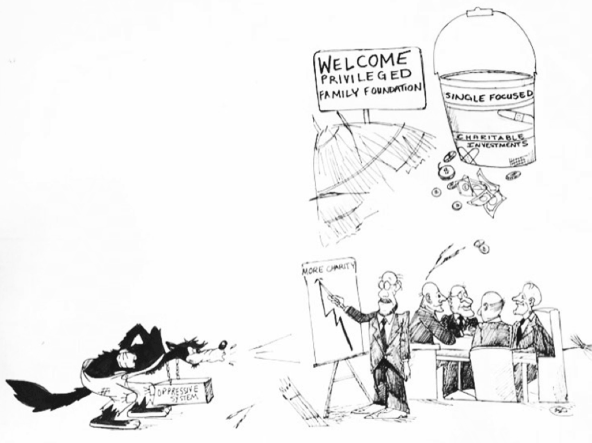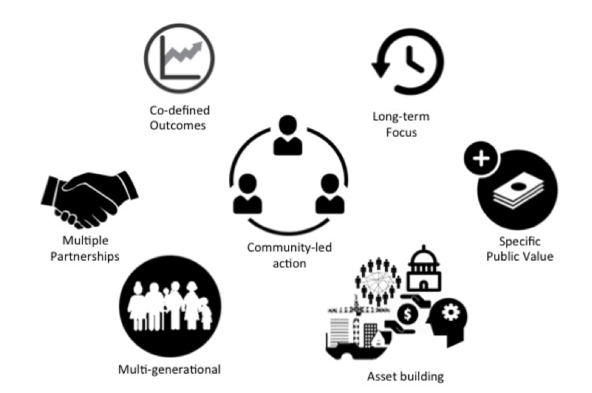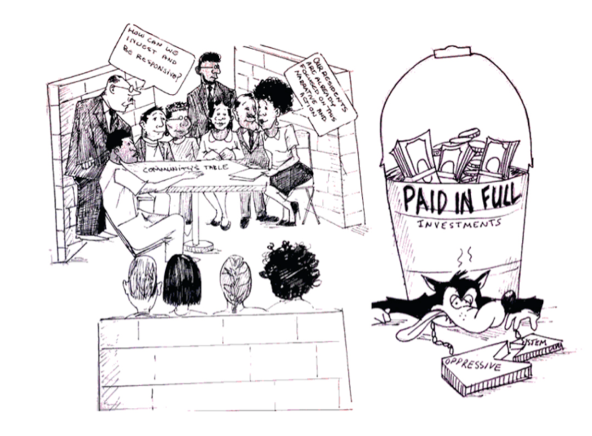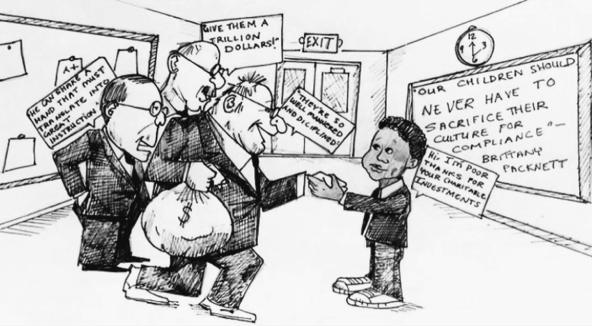Close your eyes and think about why you chose to serve at a nonprofit or a philanthropic institution. Think about the hope you had for communities, the programs you wanted to develop, the lives you desired to impact, and the fulfillment you envisioned feeling when you went home at night, believing you’d made the world a better place through your efforts to eradicate poverty.
Now open your eyes and think about why it’s not working out that way.
Philanthropic leaders, however you’ve answered that “why,” we’d like to put forward that the root of the gap between what we envisioned and reality is in the routine of our privilege, and our lack of empathy and authentic understanding toward those we’re serving. What we mean to say is that somewhere along the way, we developed a false view of ourselves and our own basic needs, and as a result decided we are drastically different from those we’re charged with serving. We decided we are different from “poor” mothers and fathers who want jobs, safe housing, and strong healthcare options. We decided their children are different from those we put to bed every night in our own houses, forgetting that “poor” kids have dreams for their lives too. We started referring to communities as “those people”; we stopped saying their names and started saying the numbers given to us by evaluators. We fooled ourselves into believing we had more to give than we had to learn, and we created strategies for them without them. We held galas in their name and didn’t invite them, and believed empowerment was ours alone to distribute through a check. We went from conference to conference, talking about the problems but doing little. We became comfortable with the mundane efforts of charity, and forgot about righting the wrongs of history through justice-oriented giving and service. We were somehow able to divorce ourselves from our shared humanity, and convince ourselves they had different hopes and dreams for their families and needed a different set of supports to get their families out of the complicated calculus of survival.
 (Illustration by Ashley Neville, Ashlaine Designs)
(Illustration by Ashley Neville, Ashlaine Designs)
This distance separated “us” from “them” and created a situation in which we were no longer able to see that the very things we bet on for our own children, spouses or partners, and families to achieve our dreams are the same bets we need to place in our daily work with communities. Instead, poverty became the new werewolf, and we had a silver bullet solution to try to put the monster down. We created isolated strategies that, in a way, made it acceptable to walk past suffering, because it didn't fit into our program portfolio.
We created isolated strategies that, in a way, made it acceptable to walk past suffering, because it didn't fit into our program portfolio.
Are you enjoying this article? Read more like this, plus SSIR's full archive of content, when you subscribe.
In the past few years, coordinated efforts through collective action and impact have made some headway—pooling resources, data, and energy to achieve common goals and mitigate poverty. However, these approaches have still proved limited. This could be due to their lack of dimensionality or authentic community engagement, or their neglect to map out a comprehensive approach to change. In what follows, we suggest an accompanying strategy to collective impact and action that is grounded in a healthier view of ourselves and others. We call this a “paid in full” investment strategy (see chart below). This strategy aims to dismantle the forces perpetuating poverty and has the potential to create ecosystemic-level changes—changes that engage networks of private and public institutions, and shift the policies and narratives that sustain their functioning toward an American landscape that is on course to fulfill its ideals.
 The seven elements of a paid-in-full investment strategy.
The seven elements of a paid-in-full investment strategy.
When you’re making an investment in the future, the interactions between different components of a system—the entire ecosystem in which the investment functions—are important for predicting a winning outcome.
Similarly, issues and/or opportunities that face communities in poverty don’t happen in isolation. As just one example, when we visited a prospective grantee in rural North Carolina we heard the story of a young girl, we’ll call her Sara, who was underperforming in class and having issues staying awake. When the school administrator called her into the office and questioned what was going on, she told them she was hungry, because it hadn’t been her turn to eat the day before. That’s not a typo. It wasn’t her turn. There is no singular investment in, let’s say, teacher effectiveness that is going to fix the urgency of hunger for Sara or the hardship her family faces on a daily basis. Broken systems have forced Sara’s parents to negotiate and make calculated decisions about putting food on the table or keeping the lights on. This calculus of survival is time-consuming and stressful, and will always be more important than anything that falls outside of life’s daily necessities.
To be clear, we aren’t saying that work on teacher effectiveness in education reform isn’t necessary, but rather that we must address multifaceted challenges with comprehensive solutions when we approach issues like health, housing, and workforce development. By pouring hundreds of millions of dollars into these areas without an accompanying strategy to address the urgency poverty presents, we are missing the mark and an opportunity for real, transformative change.
Multiple Partnerships
We fully understand the importance of niche expertise. No singular institution or organization can be effective at fixing the multitude of challenges broken systems have unloaded on our communities, nor should they. The kind of mission creep experienced by individual organizations that strive to address a wide range of problems can leave them under-resourced and frustrated by their inability to move the needle on positive change. A paid-in-full investment strategy must include multiple partners (including community, government, private, and philanthropic organizations) to build resources for comprehensive and sustainable impact. This approach allows us to blend and reposition our program portfolios so that we are taking a more holistic approach.
Once we have identified potential partners, we can then make matching investments to support the defined goal. This approach should also include philanthropic program officers building funding collaboratives to help nonprofit partners raise funds. Philanthropic teams must come out from their ivory towers and go to work for our partners on the ground, helping them build resources and expand their social capital. Your introductions will allow them to expand their reach, and focus not on the arduous daily task of corralling dollars but on what really matters in implementation. Perhaps most important to this point is that all parties must check their egos at the door. If this work becomes about building your own monument, then collaborative efforts might get lost in the negotiations for who gets the credit.
Specific Public Value
We want to acknowledge that within these types of partnerships, it may be challenging to be specific about our mission and the public value we are aiming to create in the work we are doing. In his book Creating Public Value, Harvard Kennedy School Professor Mark Moore argues that just as the private sector bases goals and outcomes on private value, the public sector must set goals and outcomes that articulate their larger value to society. While impact investing has proven that private and public sector value need not be mutually exclusive, nonprofits and philanthropic institutions must definitively determine the value they hope to create. We have adapted the following questions from Moore to help determine the public value proposition created by any action, strategy, or organization:
- What is the important “public value” the effort seeks to produce?
- What “sources of legitimacy and support” would the effort rely on to authorize the organization to take action and provide the resources necessary to sustain the effort to create that value?
- What operational capabilities (including new investments and innovations) would the effort rely on (or have to develop) to deliver the desired results?
In defining public value, we must be careful to not miss the mark with respect to what we can actually impact. For instance, if our mission is to train high-quality teachers, we might focus on recruiting quality candidates into a teaching pipeline, training them on professionally proven pedagogies, and creating some sort of career pathway in which they have room to advance and perhaps train or positively affect the induction process of other teachers. In this example, our public value is adding more quality teachers into the workforce to work with students, and perhaps building the prestige of the field of teaching. While our activities here undoubtedly have value, they would not be sufficient if, for example, the true mission were to end generational poverty. This strategy does not reflect a paid-in-full investment, given its isolated approach.
Co-defined Outcomes
The value we create is rooted in the outcomes we identify. With a paid-in-full investment strategy, outcomes are co-defined in partnership with the community to achieve ecosystemic-level changes. And as Blended Value’s Jed Emerson has eloquently stated, “You can't have deep impact or change at wholesale cost.” Nonprofits and philanthropic institutions have become extremely proficient in funding and supporting charitable activities and outputs, but have gained little ground on building those activities into systems-level outcomes that are impactful and justice oriented. In the anthology What Matters: Investing in Results, Nonprofit Finance Fund CEO Antony Bugg-Levine writes:
Almost all the funding for our social system is allocated by activities, rather than long-term results. ... For example, the homeless shelter paid by the number of beds it fills will not be in a position to provide additional therapy services that could help its clients address the root cause of their homelessness and more quickly transition out of the emergency shelter.
Activities that support and build outputs are necessary to support the daily calculus of families living in poverty, but they are not sufficient if the goal is to produce systems-level change. Yes, there are families that reside in a given system that have real, daily immediate needs (such as food and shelter) that charitable activities can temporarily solve. However, charitable activities that produce symptom-solving outputs don’t get to the root of righting the wrongs current systems produce or rebuilding structures that equitably serve all. Instead, they generate success stories that only mimic the potential of a more just system. To co-create a “new normal,” philanthropists—guided by the community—should make paid-in-full investments that support activities, outputs, and outcomes that: a) address the daily needs and the urgency of basic services experienced by the poor, and b) push toward solving the whole equation. Note that these investments will force us to talk about complex power dynamics and the often-uncomfortable concepts of race and justice. Without outcomes-based investments, we will continue to lead activities that won’t necessarily lead to impactful changes to end intergenerational poverty.
Long-term Focus
An essential characteristic of a paid-in-full investment strategy is a long-term focus, meaning investments are sustained over multiple years, geared toward building capacity over time, and adaptable to the changing conditions within the community. Too often philanthropic efforts are fickle, chasing a new social fire before extinguishing the one nearby. We have to realize that capital has very real consequences for communities and ensure that communities aren’t susceptible to additional social strains that come with the changing winds of philanthropy. A long-term focus should also be supported by the development of a matching policy agenda to address injustices created by the current system. This approach will mean serving the community’s daily needs in lockstep with systems-level needs. It has taken years for our broken systems to reach their stature, and it will take years to tear them down and build more equitable ones.
Community-led Action
Crucial to any paid-in-full strategy is ongoing leadership by the community. Nonprofits and philanthropists need to be responsive to community leadership in creating and implementing strategies, rather than simply delivering their own solutions.
We have attended a plethora of strategy meetings where attendees are homogenous and where there is no community representation. But representation is not the right solution either: It’s not a matter of just giving community members a seat at our table—we must ask for a seat at theirs. Tables full of highly capable and passionate leaders already exist in the community. These are the people who have relationships with—and understand the mindsets and aspirations of—the youth, families, and residents we hope to serve.
 (Illustration by Ashley Neville, Ashlaine Designs)
(Illustration by Ashley Neville, Ashlaine Designs)
By either intentionally or unintentionally excluding the communities we’re hoping to impact, we echo a sentiment we described in our previous article, “Shifting Philanthropy from Charity to Justice”: Philanthropists and nonprofit leaders are often on top of situations, rather than on tap, and seek to involve and include, rather than to serve and respond, to community leadership. We have as much to learn from communities, as we have to give, and if we are truly interested in making paid-in-full, transformative investments, no collective impact model or action should be enacted without leaders from the community at the helm. In other words, no decisions should be made about communities, without communities.
Part of this process is determining which nonprofits to support and which to divest of. Not all nonprofits need to exist, especially ones that are complicit in sustaining the conditions that foster inequality and that profit from treating the symptoms as their end goal. As we mentioned in our previous article, philanthropy tends to reward organizations that can tell “the worst story the best." We reemphasize that it’s dangerous to pit grantees against each other for resources, where each is vying to tell the most-compelling, problem-based story about the communities they aim to serve. We must remember that communities are much more than a handshake and a sob story. Instead, we suggest that communities be at the forefront of exercising control over their own narratives, rather than playing out those we create for them. This is the definition of community-led.
 (Illustration by Ashley Neville, Ashlaine Designs)
(Illustration by Ashley Neville, Ashlaine Designs)
We must focus on investments that increase the capacity of individuals to become the heroes and heroines that lead change in their own communities—as a matter of justice over charity. Most importantly, we must make investments that focus on building ownership, wealth, and power within communities to replicate their own resources so that they are not dependent on the short-term opportunities philanthropic dollars present. This is foundational to a paid-in-full investment strategy.
In making decisions about which organizations to support, philanthropic institutions and nonprofit organizations must rely on the community as a primary evaluator and source of evaluation. At the very least, they must seek to have people representing their community in prominent positions (with decision-making power on their board and leadership team) and must partner with organizations led by people of color (especially if they are not a minority organization themselves). A nonprofit that is 90 percent black or Latino serving a 90 percent white community would potentially turn heads or even raise red flags—yet we frequently see the reverse and continue to invest. This is philanthropy perpetuating inequality, just at tax-deductible rates.
Multiple Generations and Asset Building
A paid-in-full investment strategy should also create value across multiple asset areas that build on each other for multiple generations. Going back to our earlier example, the student Sara’s entire family was part of the systemic challenge she faced. Investments, then, should seek to build wealth to address the needs, dreams, and ambitions of individuals in multiple generations. It has become popular and socially acceptable to direct efforts solely at youth, rather than people in later life. But when we consider efforts focused on youth, we must also consider their parents, caregivers, and grandparents. To end poverty, we must consider the well-being and mobility of all the people in a community. We must develop strategies in the whole and build assets—including social, physical, financial, and political capital—to form the basic structure needed for the kind of prosperous community we outline below. (Note these characteristics are a starting point, not a comprehensive list, and are adapted from a framework developed both by researcher Ron Ferguson and Kia Baker of the Southeast Raleigh Promise).
- Residents should feel secure and safe in their home and in their neighborhood, free from the presence of violence and/or overly policed environments.
- Neighbors should have the collective autonomy and resources to find solutions to their problems, with the unencumbered and “no-strings-attached” support of private and public partners.
- Neighborhoods should have equal voice in determining local political outcomes without systemic barriers to their access and, as tax-paying citizens, receive quality services without having to spend continuous energy and resources on advocacy.
- Residents must have the basic means to acquire and access work opportunities within their community that provide a safety-net, while working to develop and invest in wealth-building opportunities. Jobs should have basic benefits, career-building opportunities, wealth-building opportunities, and a fair and engaging workplace.
- Local businesses should be competitive, as well as integrated into the regional economy, including the channels through which finance, technology, and information about trading partners flow to both existing businesses and new entrepreneurs.
- Communities should have a critical mass of business ownership as to prevent economic leakage by ensuring that dollars and resources do not leave the community and long-term wealth generation can begin to build.
- Well-maintained housing should be affordable for current residents, and market-rate financing and insurance should be affordable for housing investments.
- Schools should make students civically ready. Students should acquire the skills and necessary habits of mind to make educated decisions and to positively contribute to a democratic system. They should also acquire levels of proficiency needed to attend college or secure some type of post-secondary vocational certification with labor-market value that leads to gainful employment and a career of their choosing.
- School curriculum and instruction should be culturally competent and responsive, as well as ensure that students learn social connectivity and self-efficacy/agency.
- When brought to trial, people should be tried by a jury of their peers and people from their immediate communities. Neighbors should be supported by the criminal justice system in their community-based restorative justice practices and self-policing activity.
- Communities should have equal representation in media outlets while being able to offer complete narratives of their community and the way media represents them to external actors.
- Reliable and affordable health care should be readily available, with quality physicians and practitioners focused on the health and well-being of their patients through quality health care, nutritious food, and physical activity.
- Communities should have access to fresh, affordable produce and local groceries in close proximity to where they live.
- Communities should be free of predatory revenue streams collected by municipalities, counties, and cities, as well as predatory financial institutions.
- Public arts and cultural institutions should have dedicated spaces that reflect community interest. Institutions that celebrate the community’s culture and heritage should be readily available, as should creative spaces that expose residents to a diversity of different cultural, ethnic, social, and sexual orientations.
We’ve mentioned throughout that communities must be at the helm of progress. Being responsive to community leadership requires that we develop empathy and understanding in the hope of shifting narratives, but we must also bring an accompanying sense of duty before we can move our communities into healthy standing. This sense of duty is necessary in the face of the historical inequities that—without the fair acknowledgment of their devastating effects—cause many to unfairly benefit while others continue to suffer. Empathy alone is often framed as a noble choice—commendable when acted on and a non-issue otherwise. We pay little attention to things that people don’t do. However, duty says this “omission to act” is inhumane and unjust. Empathy without the duty of action is dangerous; our courageous conversations must be met with courageous action.
We must focus on investments that increase the capacity of individuals to become the heroes and heroines that lead change in their own communities.
Lastly, we must also acknowledge one of the main barriers to achieving true transformative change: Many affluent people are willing to make what we call the “moral tradeoff of privilege” to maintain their current status in society. That is, many are willing to address justice in principle but are unwilling to make any trade-offs that will ensure that justice is a reality for all. And while poverty is not a choice, the moral trade-off of privilege is—and it’s a choice that will always make it necessary for the poor to make the moral trade-off of survival. In other words, if any of us found ourselves in the confines of a neighborhood with little access to opportunities or the basics of survival, we’d probably make calculated decisions to gather the limited resources available to live and feed our families. Placed in survival mode, we doubt that the majority of us wouldn’t fight, rob, or even kill to ensure that our daughters didn’t have to take turns eating. Developing the duty of empathy and action will enable us to understand the system and create new narratives that are foundational to developing an investment strategy. The new narratives we create using this “proximate” understanding will shift from “us vs. those people” to seeing a unified us eradicating broken systems that are not adequately and inclusively serving all.
We end on this note: With partial investment strategies, we can create only outliers of success. These success stories, sprinkled throughout our annual reports and materials, arise from instances where a momentary low tide enables a small few to maneuver a life raft through a stormy sea to shore. But if we don’t comprehensively change the network of systems producing the storm of inequality, eventually the sea will swell and consume the escape route for all those behind. Instead, we must co-create a new normal for systems-level change and equity, and the social sector—guided by the community—we must make paid-in-full investments.
Support SSIR’s coverage of cross-sector solutions to global challenges.
Help us further the reach of innovative ideas. Donate today.
Read more stories by Brian C.B. Barnes & Dorian O. Burton.

